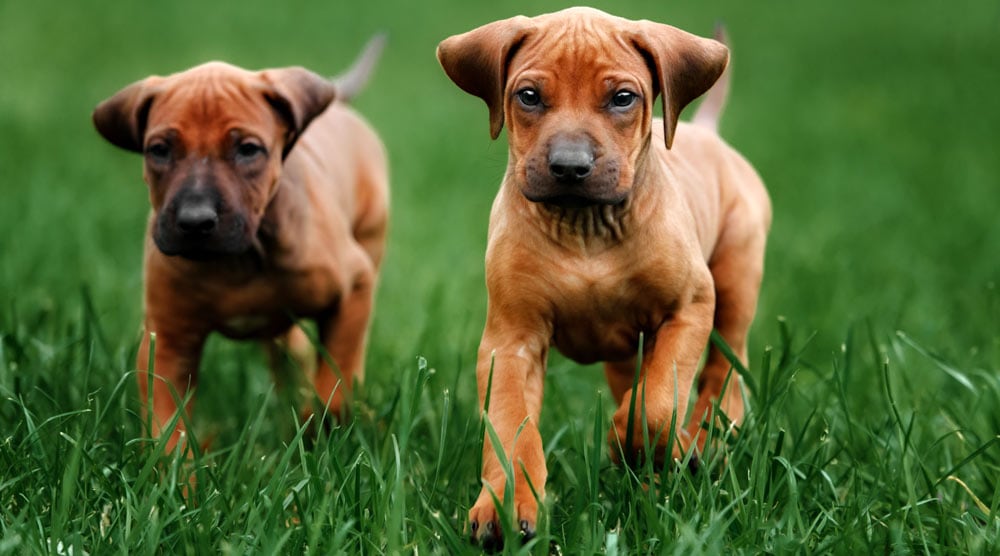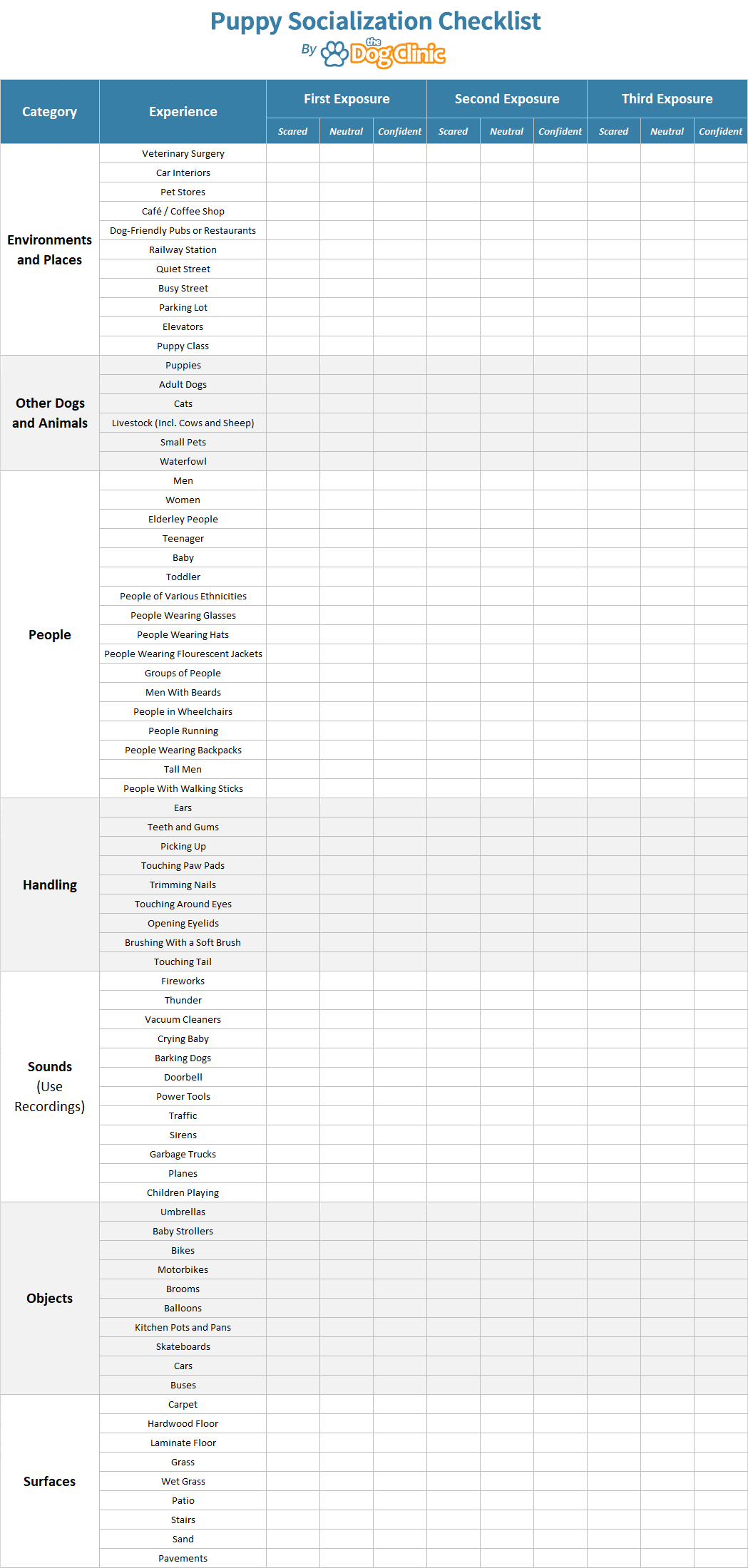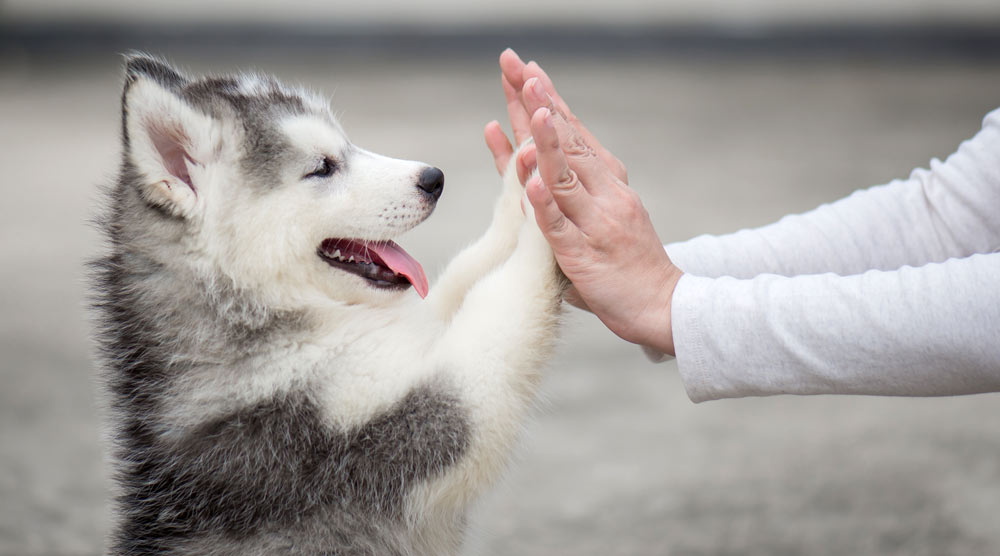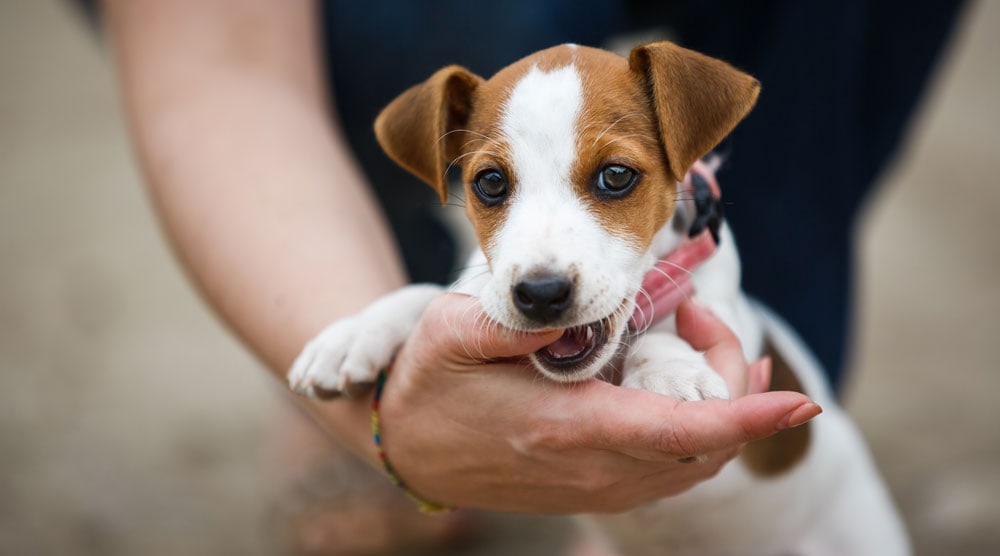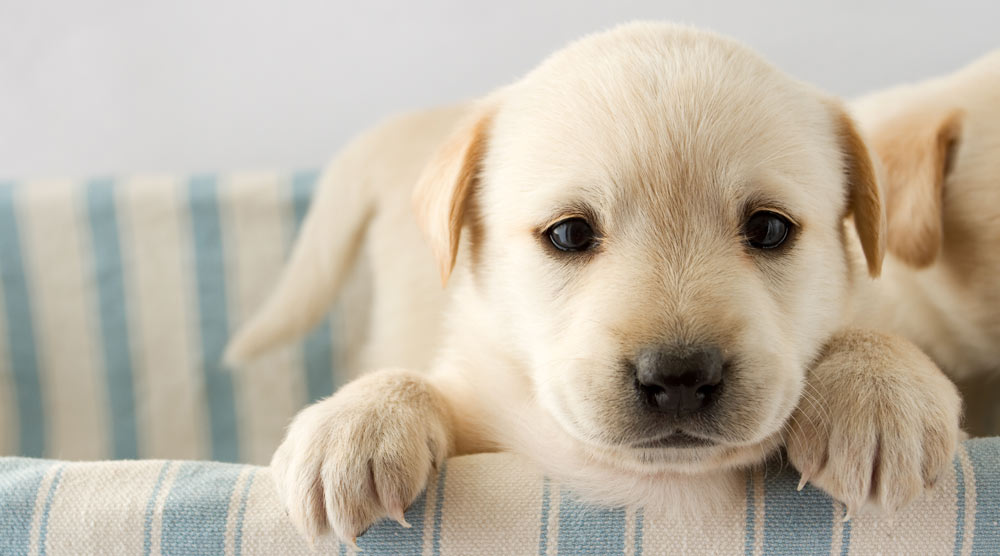Did you know a 2017 study showed nearly a third of puppies get minimal socialization opportunities?
Contents
- What Is Socialization and Why Is It Important?
- When Should You Start Socialization?
- A Guide to Puppy Socialization
- How to Socialize a Puppy With Other Dogs
- Tips for Socializing a Puppy Before Vaccinations
- How to Socialize a Puppy With Humans
- How to Socialize a Puppy to Other Animals (Including Cats!)
- How to Socialize a Puppy to Noises
- How to Socialize a Puppy to Body Handling
- How to Socialize a Dog to Common Environments
- Is It Possible to Socialize an Older Dog?
- Puppy Socialization Checklist
- Summary
This guide will teach you how to positively socialize your puppy. The goal is to help your dog feel safe and confident in a variety of situations. By doing so, you’ll strengthen the bond you have with your puppy and increase the chances of a relaxed and adaptable adult dog.
Tip: Just want to view the checklist? Click here to jump straight to it.

What Is Socialization and Why Is It Important?
If this is your first time raising a new puppy, you’ll likely be advised to enroll in a puppy class for some ‘socialization.’
Socialization is about much more than just attending a weekly class though. It’s about appropriately exposing your puppy to new stimuli during those crucial formative weeks and months of their life.
Studies show that inappropriate, minimal or excessive socialization can lead to fearfulness, anxiety, aggression and other problem behaviors in dogs.
New owners often misguidedly think that taking their dog to a hectic puppy party and allowing them to be cuddled by lots of children is all that’s required. This type of uncontrolled exposure can actually do more harm than good.
The focus should be on gradual, unforced, calm and positive introductions to as many new things as possible – not just people and dogs. Some of the things you’ll want to expose them to include (see the checklist below for a more complete list):
-
1Visiting the VetYou don’t want the vets to only be associated with scary procedures.
-
2Car RidesTo minimize the chance of developing stress-related travel sickness.
-
3Meeting a Variety of PeopleIt’s important for a puppy to meet both children and adults.
-
4Meeting People With Distinguishing FeaturesFeatures like sunglasses, umbrellas, hats, wheelchairs and beards could be intimidating.
-
5Meeting People of a Variety of EthnicitiesThe ideal socialization schedule should include people of different ethnicities.
-
6Noisy AppliancesExamples include hairdryers, washing machines, vacuum cleaners and lawnmowers.
-
7Busy Sidewalks With TrafficTraffic can be intimidating for a dog who hasn’t experienced the noise and speeds before.
-
8Fast-Moving Objects and VehiclesExamples could include bicycles, scooters, skateboards and joggers.
-
9Other AnimalsPuppies should be socialized with livestock, cats and small furries.
-
10Pet-Friendly Stores or CafesThis is especially important if you’re planning to take your dog to public locations.
-
11Scary NoisesAll noises commonly associated with fearful behavior, like fireworks, thunderstorms or sirens.
When Should You Start Socialization?
Puppies go through their most significant learning and developmental curve from the ages of around three weeks to three months. They are like little sponges that soak up all the experiences they have during this time.
From four to sixteen weeks of age, the puppy enters what is called the Socialization or Sensitive Period. The experiences your pup has during this timeframe are the most influential in shaping your dog’s future behavior.
This means that by the time your puppy is ready to be collected, usually sometime between eight and twelve weeks, they are fully into this Sensitive Period. You should continue their socialization in incremental steps from as soon as they arrive in their new home.
The Importance of Breeders and Socializing
One of the many reasons it is important to find a reputable breeder is because they are in control of your puppy’s socialization in those crucial early weeks.
This was backed up by a 2017 study conducted as part of the Guide Dogs for the Blind Breeding Programme. The study showed that a controlled and positive increase in sensory stimulation and human contact during their first six weeks resulted in pups that, by eight months old, were less likely to become distracted or anxious.
A good breeder will make sure they are providing the puppies with regular and positive handling and enrichment, and gradual introductions to different noises, smells and other stimuli.
Sadly, it is estimated there are still over 10,000 puppy mills operating in the US alone. If your puppy comes from a pet store, backyard breeder or a puppy mill, you can be unintentionally supporting an industry that is rife with cruelty and health problems. On top of all of this, the puppies are usually very poorly socialized.
If your pup has not had the right start in those very early weeks, it can have a devastating impact on their future behavior.
If you’re adopting from a shelter, it can be useful to find out what sort of socialization the staff have introduced for puppies in their care. A good shelter may match puppies up to foster homes or have a more structured approach to handling and enrichment in the kennel environment. Be aware that shelter puppies may be more nervous than the average puppy though.
A Guide to Puppy Socialization
There are many different things your puppy should interact with, including people, animals, objects and different environments. The core socialization process and training, however, is always similar.
- Key Point #1: New things should always be introduced slowly and safely, to make it an enjoyable experience for your pup. Reward them for any bravery, curiosity, and calm interactions with praise, yummy treats or even a game with their favorite toy.
- Key Point #2: You should learn to recognize when your pup is showing signs of being stressed or fearful. It will be obvious if they are trying to run away, trembling, or their tail is tucked between their legs. But you should also look for more subtle use of body language. Common examples include yawning, lip licking, scratching and sniffing other objects.
- Key Point #3: Never force your dog into an uncomfortable or scary situation. Some people think that eventually the dog will just relax and ‘get over it,’ but you could actually be creating a lifelong fear. The more they are forced into it, the greater chance of fear aggression Instead, let them make the first move and reward any positive engagement.
- Key Point #4: Always choose quality interactions over quantity. You want your dog to have lots of experiences, but overdoing it can cause more harm than good.
How to Socialize a Puppy With Other Dogs
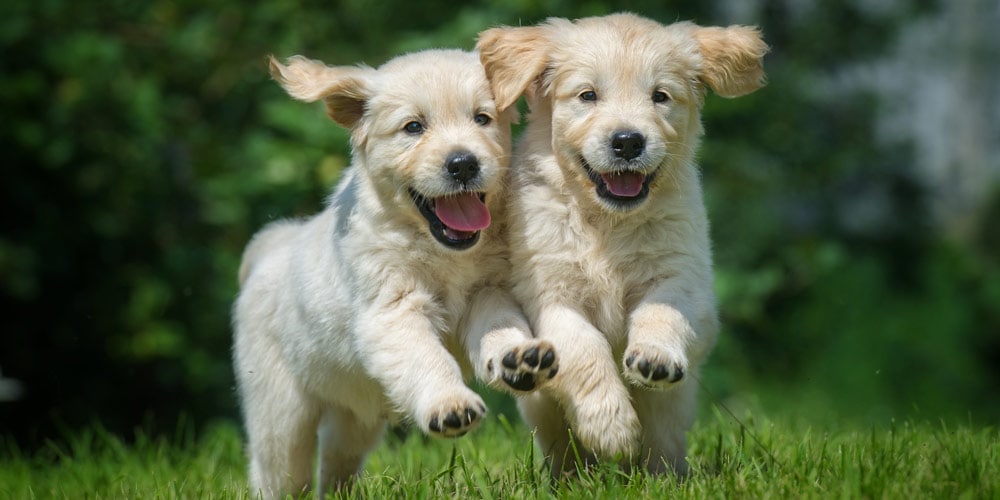
While introducing your pup to lots of new young and adult dogs can be beneficial, don’t allow them to approach just any dog.
Planned meetups with dogs that have been selected because of their temperament can be advantageous. Placid, relaxed, gentle, easy-going dogs will help to create a positive experience for your pup. Always reward calm interactions and remember to step in if your puppy is becoming over-aroused or uncomfortable.
Be aware of size differences. If the dog is much bigger and stronger than your pup, without close supervision, it could result in an accidental injury.
Also be aware of the differences in play and communication styles of different breeds. Sight hounds, for example, enjoy chase games – but other breeds can find their erratic movements over-stimulating or frustrating.
By getting to know dog body language, you’ll be more confident about recognizing the difference between playing and fighting.
Play bows, relaxed open-mouthed expressions, and rolling to expose bellies at the same time as the growling and wrestling, are a good sign. If there is stiff body language, closed mouths, curled lips and raised hackles, then it is best to remove your pup as things can escalate quickly.
Meeting in neutral territory, or at least an open area like a garden, is often a better option than in another dog’s home. They could be uncomfortable with a new dog invading their space.
Click the plus signs below for more information about specific dog-meets-dog scenarios and how to handle them. You may also want to read our guide to whether two dogs in a household are bonded.
It’s not uncommon to have a puppy with no recall approach an on-leash adult dog who isn’t keen on other dogs. If the owner of the dog explains this, the common response is not to worry, it will be good for the puppy to be ‘told off’ and it will ‘help them to learn.’
It is true, a pup can learn a lot about manners and appropriate greetings from other adult dogs. An aggressive reaction, however, can make your pup fearful of other dogs in the future, or it could result in an injury.
Even if the dog doesn’t react, if they aren’t comfortable with an over-enthusiastic puppy in their face, it is not fair to inflict this on them. Be respectful of other dogs need for space, and teach your puppy to be respectful too.
If you already have a dog at home, this could be the first time your pup will have met another dog outside of their litter.
Remember, your puppy is likely to be overwhelmed, scared and anxious about leaving his litter and entering a new home, so introductions should be done slowly.
You may want to introduce some crate training and also use baby gates. These can be useful to allow your adult dog space when needed, and for when you are unable to supervise interactions.
When used appropriately, a crate can also be a fantastic space for your pup to retreat to for relaxation, comfort and security. It should never be used as a punishment space or to keep them contained for lengthy periods.
We don’t recommend a dog park for socializing your puppy.
It can be hard to evaluate whether the other dogs will be friendly. Parks can also be an overwhelming experience for your pup, especially if during busy times. A lot of owners don’t properly supervise their dogs and situations can quickly escalate from seemingly playful to full-on aggression.
Even if the other dog is “well-meaning,” many dogs don’t understand polite greetings and play, which could have a negative impact on your pup’s socialization.
Look for a class run by a qualified trainer who promotes force-free, scientifically proven positive puppy training techniques and offers a structured program. Good classes can book up months in advance. You want your pup to be enrolled while they are still in that crucial Socialization Period, so be organized to avoid disappointment.
While it can be nice for the pups to have some play-time, the class should not just be a free for all, where the pups get to run riot. While this may tire your pup out, you aren’t teaching them any impulse control, and it encourages wild behavior. For nervous pups, it can actually increase their anxiety levels.
If your pup is nervous, allow them to take things at their pace and reward positive interactions. If they want to watch from the sidelines for a bit, this is fine. If they then choose to have a little butt sniff, reward them with a yummy treat. The more this happens, the more your pup will realise that calm interactions with other dogs mean good things happen.
Arranging other social interactions with dogs is important - you shouldn’t just rely on a puppy class. Some classes will not allow your pup to attend until they are fully vaccinated. Plus they only offer an opportunity to socialize with other puppies, and in one specific environment.

Tips for Socializing a Puppy Before Vaccinations
In days gone by, it was widely recommended that puppies should not venture much out of their home environment until they are fully immunized. This can sometimes be between 12 and 16 weeks.
Nowadays, there is greater recognition of the importance of socialization during that crucial learning window.
The American Veterinary Society of Animal Behavior points out that the risk of developing a disease during this time is minimal, especially if extra precautions are taken. The risk of developing serious behavior problems in later life as a result of lack of sufficient socialization, however, is much higher.
If you want to get out more with your pup, you could carry them, or invest in an appropriate carrier, making sure to introduce it positively.
Why not pop round to friends for a visit, especially if they have a friendly vaccinated adult dog? Short trips in the car can be good. You could even go to a park and contain your pup on a large blanket so that they can watch the world go by.
Some puppy classes also allow unvaccinated puppies to attend. You just need to make sure that they place great importance on hygiene and cleaning procedures.
How to Socialize a Puppy With Humans
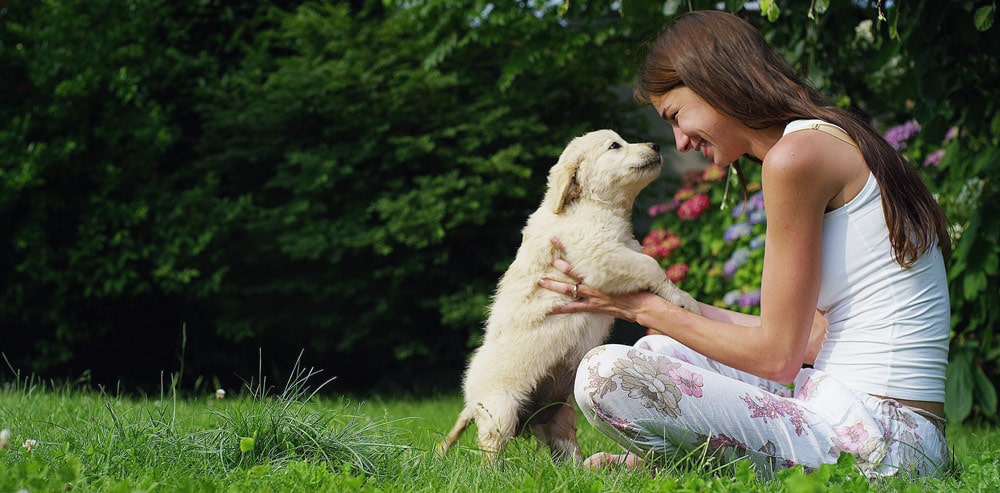
Respected Vet and Animal Behaviorist Dr Ian Dunbar, talks about the importance of introducing your puppy to as many different people as possible. He suggests they will benefit from having had interactions with at least 100 different people by the time they are three months old.
If your pup only has contact with their immediate family, it can lead to a dog that can’t relax around new people and, in extreme cases, your dog could become people aggressive.
Of course, if these interactions are forced, frantic or stressful, then it is defeating the purpose. They should be planned and purposeful.
Click the plus buttons below to learn how to socialize a puppy with family members or strangers.
Start by having close friends or family visit the house, as introductions in a familiar environment are less overwhelming. If you plan to use a dog walker when your pup is old enough, having them come for puppy visits could also be helpful.
Visitors should let your puppy approach in their own time - don’t force them into the person's lap. They should be instructed to reward the puppy for calm interactions, but ignore the dog if its jumping, barking or performing other over-excited behavior.
If your dog is too nervous about approaching initially, you could have your ‘Stooge’ throw some treats on the ground. This will help your pup associate them with good things.
Try not to lure your pup to approach with food though. You want them to feel comfortable enough to approach without a bribe. Instead, reward them with a treat for making a choice themselves.
If children are visiting, they need to understand the ‘puppy rules’, and they should be quiet and gentle. Even if the puppy is confident around them, overexcitement can lead to accidental injury or cause the pup to start nipping.
Once the pup is out and about, you want to meet as many different people as possible. Just because they have met some children in your home that know the rules, doesn’t mean that they will not be wary of a group of kids at the local park.
Some dogs are also warier of men. Get lots of amenable male volunteers to help - including men with beards, deep voices, or those wearing hats or uniforms.
Negotiating the sidewalk can be an intimidating prospect for your pup at first. People with buggies, walking sticks, umbrellas, kids on scooters, the list goes on.
Keep new introductions short and don’t try to do too many at once. You don’t want to overwhelm your puppy.
How to Socialize a Puppy to Other Animals (Including Cats!)
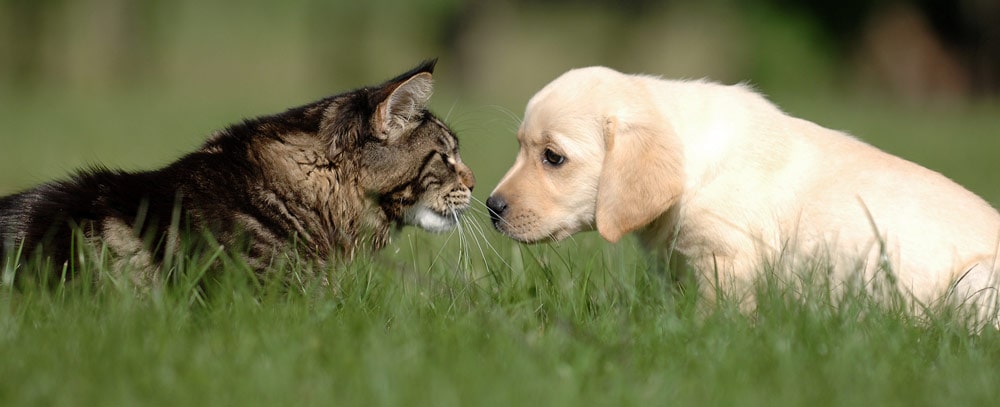
Making sure your pup has positive interactions with other animals can make it easier to introduce new pets to the household. It can also help if you encounter them on walks.
Of course, genetics play their part too. Terriers or Sighthounds, for example, often have a higher natural prey drive than other breeds. But by starting introductions and training at an early age, you can decrease the intensity of this drive.
Here are some tips for socializing with cats and other animals:
If you have cats in your household, careful introductions may be needed. Baby gates can be a helpful management tool. Your cats should always have an escape route, and they should never be forced to interact. Sometimes introductions between cats and excitable puppies have to be built up over several days or weeks.
If you have a particularly territorial or nervous cat, it may even be best to keep them in entirely separate rooms initially. You can pop an item, like a toy or blanket, belonging to the puppy in the cat’s room and vice versa, so that they get used to each other scents.
Doing initial controlled introductions with the pup on the leash can also be useful.
Your dog, regardless of their age and recall ability, should never be off-leash around livestock. You can introduce them carefully to these types of animals from an early age, encouraging calm observation from a safe distance. This can help to minimize any overexcitement or nervousness as they mature.
Care should be taken around rivers with waterfowl too. Swans can be particularly aggressive if they feel threatened, and you don’t want a young pup to swim out into fast-flowing water either.
Be particularly careful when socializing a dog with a small pet, such as a rabbit or guinea pig.
Start by allowing the leashed puppy to see the animal inside its secure cage, while rewarding for calm behavior. If the animal is scared or your puppy is too excited, remove him and try again another time.
Over time, you may be able to gradually lengthen these meetings until - eventually - the animal can be out of the cage (but the dog is still on a leash). Continue to reward calm behaviour. It's only when the dog has shown he isn't going to chase or behave aggressively towards the animal that you should consider removing the leash.
Keep in mind that some dogs may never be trustworthy around small animals. Those with high prey drives, in particular, might always chase the animal.
You should also remember that this process could be terrifying for a small animal! If you see any signs of stress from either your dog or your small pet, stop the interaction.
Never leave your dog alone with a small animal - even if he hasn't shown any signs of aggression towards your other pet.
How to Socialize a Puppy to Noises
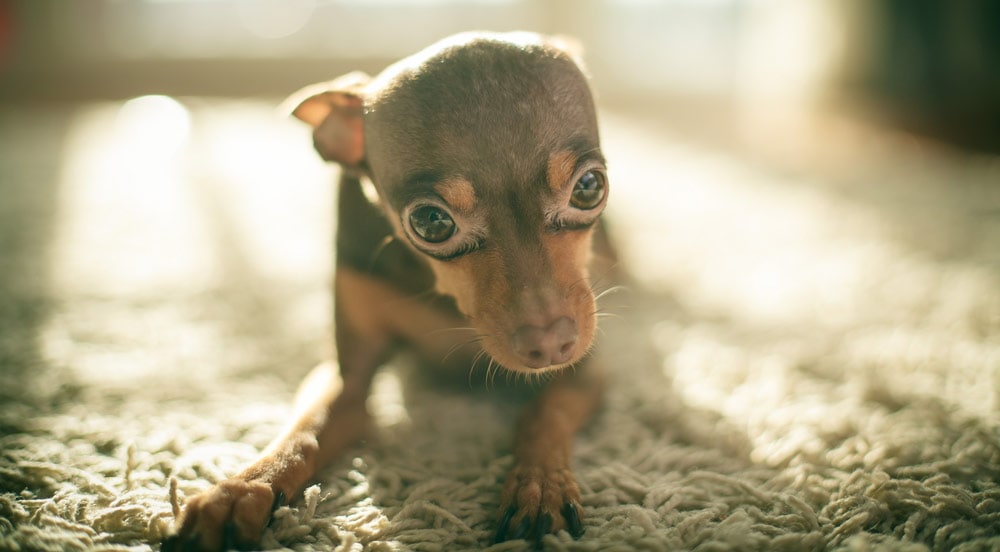
It’s not uncommon for dogs to become anxious during a thunderstorm or fireworks season. For some dogs, this can be incredibly stressful and, in severe cases, medication can be required to help them cope.
Gradually desensitizing your pup to different sounds and volume levels can decrease the chances of them having sound sensitivity in their adult life.
It’s possible to pick up noise therapy CDs or downloadable mp3s. These contain a variety of different sounds that can trigger anxiety in dogs. They are played at an extremely low volume initially, and your dog receives lots of rewards at the same time to create a positive association.
Over a very gradual period (usually at least a couple of sessions a day over a few weeks), the volume will be slowly increased. This will allow your dog to become accustomed to the noises without triggering any anxiety.
Often dogs can develop a phobia of big, noisy, household appliances too. The vacuum cleaner is a common example.
Instead of switching on the vacuum cleaner straight away in front of your pup, build things up slowly over several sessions.
Bring it out without switching it on or moving it. Leave it in the room and let your dog approach it in their own time. When they get close to it, you can reward them with a treat. Then let them go over and touch it, and reward them again. Next start moving it around a little, although not directly towards them. If they show no signs of being uncomfortable, continue to reward and repeat.
Once they show real enthusiasm when the vacuum cleaner is brought out, in anticipation of a treat, you can start switching it on. Only for a couple of seconds to begin with, and not right next to your pup. Continue to reward any calm reaction.
By using an approach like this, you are building up positive exposure to things without forcing or overwhelming your pup.
How to Socialize a Puppy to Body Handling
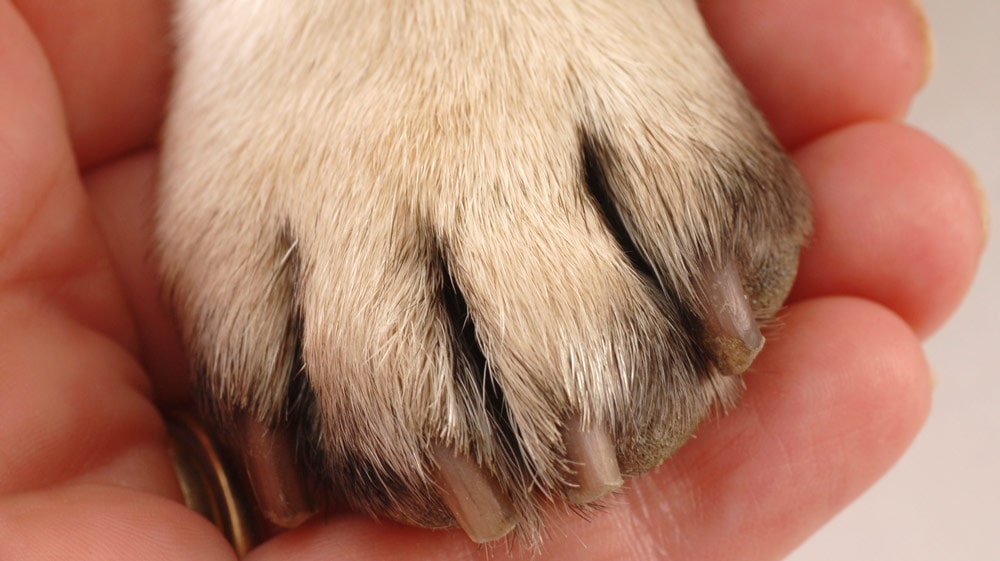
Sometimes, you may be so focused on letting your pup meet lots of dogs and people, you forget the importance of smaller socialization techniques. If your dog is not used to being handled regularly, this can cause stress and difficulty for veterinary examinations or trips to the groomers.
It can even make simple things like putting on a harness, administering medication, or clipping nails an ordeal.
You should work on making sure your pup is comfortable with you examining his paws, ears, eyes, groin, mouth and other parts of the body. This can make it easier to do some of the tasks mentioned above. It also promotes calm behavior and strengthens the trust between you both.
Keep handling sessions short and regular. Start with just gentle touches, and always reward your pup for calm and relaxed behavior. You can then build up frequency and duration.
Once they are relaxed with you handling them like this, you can introduce the same types of training sessions with other people. This will mean they are even more likely to be relaxed if the vet or the groomer is handling them too.
You may also want to introduce any grooming tools you’re planning on using. Dog nail grinders, for example, should be socialized early on to avoid your pet becoming scared of the noise.
How to Socialize a Dog to Common Environments

Where do you imagine taking your dog when he’s older? Socializing him to these environments can make future trips less stressful.
A good example is making regular trips to the vet. Just popping in, asking for some calm behavior in the waiting area, rewarding this and then leaving is enough. By teaching your dog that the vet means good things, there is less chance of it being a stressful experience in the future.
If you enjoy meeting friends for coffee, getting your pup used to settling in a dog-friendly cafe could be handy. The same is true for pub gardens.
For camping enthusiast, setting up a tent in the garden and allowing your dog to explore and relax in and around it can be helpful before you head off with them on holiday.
If you live in a very rural and peaceful environment, making trips into a town or city can prevent your pup from being nervous in busier spaces. Exposing them gradually to traffic, pedestrian areas, public transport, or even things like escalators and lifts can all be helpful.
Unfortunately, some dogs will never appreciate being taken to busy places, such as pubs or cafes – even if you take them there as a young puppy. Proper socialialization makes this less likely though.
Places You SHOULDN'T Take a Puppy
As already mentioned, this type of environment is too unpredictable. There could be irresponsible owners, and dogs that do not have appropriate social skills. There could be lots of dogs off-leash that you don’t know. If they are overly rough or aggressive, your pup could become fearful of strange dogs.
Offering your pup the chance to socialize at a well-run puppy class, and with carefully selected adult dogs, is a much more sensible option.
Too much, too soon can be just as harmful as not enough socializing.
For example, if you’ve only had your dog for a few days, don’t take them to stand in the crowd of your son’s baseball game. The noises, smells and sights are too overwhelming.
Some environments may never be suitable for your pup. Taking them to a fireworks display is not likely to be a good choice for any dog, even if they seem fine with the firework noise on a CD.
If you’re carrying your pup in advance of being fully immunized, don’t take unnecessary risks.
Avoid contact with stray dogs, and don’t put them down in public areas which are regularly used as a toilet area for other unknown dogs.
If unsure, always check with your vet before visiting an environment.
Don’t be tempted to nip into your local shop and tie your pup up outside, even if it is only for a minute.
Your puppy could be frightened by something in their immediate environment without you being there to reassure them. Worse still, they could be stolen.
Is It Possible to Socialize an Older Dog?
While early socialization is the most effective for a dog, it’s never too late to start. If you have a rescue dog, or you didn’t do enough when your dog was a pup, there are still lots of things you can do to help your adult dog feel relaxed when dealing with new things.
Depending on your rescue dog’s past, they may never have been exposed to certain things. By working on lots of short and positive introductions, in a similar way that you would with a puppy, you can often see great improvements. It may just require a little more time.
The key is to take things slowly. Always remember to start with the least stressful environments and build things up from there.
If you take your new dog into a crowded street with lots of cars and people on the first day, for example, you’re not setting them up for success.
It’s even more important to monitor your dog’s body language. If you continue to push your dog into a situation despite him feeling stressed, he may react out of fear and desperation.
If your dog is showing signs of extreme anxiety, it may be beneficial to seek the help of a qualified Canine Behaviorist or Dog Trainer. They can help you to formulate a detailed program of counterconditioning and desensitization. These techniques are used to change a dog’s response to a particular stimulus from fearful to positive.
Puppy Socialization Checklist
A socializiation checklist is a great way to keep track of your puppy’s exposure and progress. Print off the checklist below to identify new experiences your puppy might need. We’ve included the option of tracking up to three exposures for each experience, along with options for how your dog reacted.
Don’t get overwhelmed! The checklist contains a lot of experiences, but you can often tick off many on a single trip. Carrying your dog down a busy street, for example, could expose your dog to lots of different people, objects and vehicles.
You also don’t need to tick off every experience. Just aim for as many positive interactions as possible without overwhelming your puppy.
Summary
With good planning, patience and positivity, you can help your puppy develop into a confident, relaxed and well-mannered adult dog.
We know that socialization should start as early as possible, so don’t underestimate the importance of finding a responsible breeder that sets up good foundations.
When your pup arrives in their new home, you need to find a good balance. You want to introduce them to as many new things as possible – not just people and other dogs. However, these introductions and new experiences need to be carefully managed to make them a success.
Forcing your pup into a situation they are uncomfortable with will only achieve a fearful reaction. Don’t forget to pair any introduction with lots of rewards, so they learn to associate it with good things.
Socialization can be a great adventure for you and your pup, and it’s also a perfect way for you to strengthen your bond of trust right from the very start.
